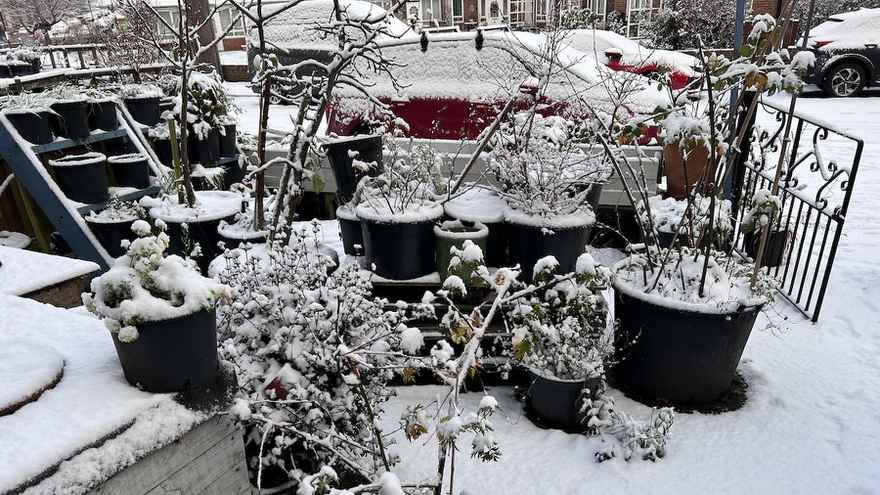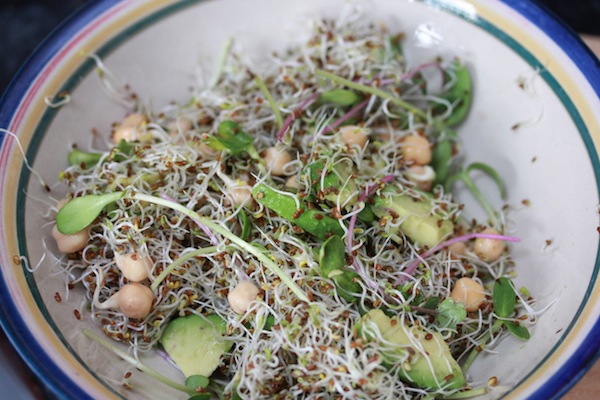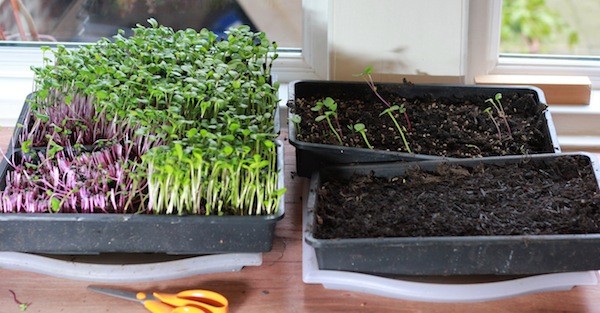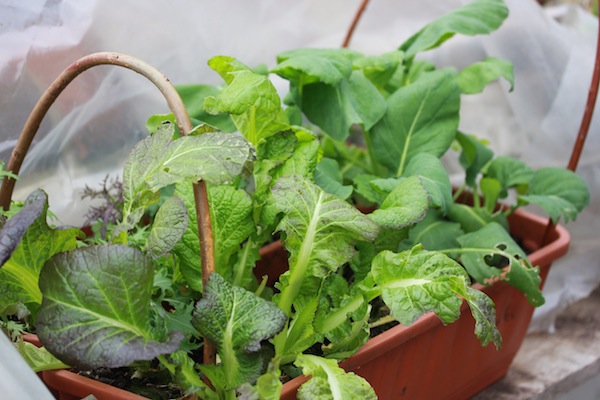What to do in December

As we enter the dark, cold days of winter, you can still keep up your supply of fresh, highly nutritious food by moving some of your growing inside. With just two or three large jam jars for sprouts and four or five seed trays for leaves you can even be self sufficient in salad. The salad you grow will taste better than almost any salad you buy in the shops at this time of year - and it will cost you a fraction of the price.
Jobs for this month
- Make a sprouter (or three).
- Create a mini microleaf and shoots farm.
- Maintain outdoor winter crops, harvesting them sparingly.
- Enjoy planning and scheming for next year.
1. Make a sprouter
Sprouts are an amazing and extremely healthy food. If you've not eaten sprouts much before, you may find it will take a little time to get used to them and learn how to use them. Persevering - to find which sprouts you like and how to use them in your cooking - is really worth the effort.

Working out ways you enjoy eating sprouts can take a little experimentation. This is a simple salad made with alfalfa sprouts, chickpea sprouts, radish shoots, sunflower shoots, avocado and lemon and olive oil dressing.
Sprouts are so easy and quick to grow - and can be done at extremely low cost. All you need is a large jam jar - you can read all about how to do it here.
 All you need to sprout is a large glass jar. These are alfalfa sprouts, sometimes seen described as one of the most complete foods there is.
All you need to sprout is a large glass jar. These are alfalfa sprouts, sometimes seen described as one of the most complete foods there is.
To grow sprouts in any quantity you'll need a lot of seeds - and so you'll want to find an affordable seed supply. Many sprouts, including lentils, mung beans, chickpeas, fenugreek and peas can be sprouted just as well from seed pulses sold for cooking. Alternatively, buying sprout seeds in bulk (eg 500g bags), will usually cost you a fraction of the cost of buying the small packs of seeds sold for sprouting (in the UK, I use Sky Sprouts).
2. Create a mini microleaf farm
To grow micro leaves and shoots inside you need a reasonably bright window or grow light. I sometimes grow mine on four plastic trays on a small table, next to the window.
 Indoor growing (without a growlight): radish and sunflower shoots in trays on the left; coriander and cabbage shoots sown and about to emerge in the trays on the right.
Indoor growing (without a growlight): radish and sunflower shoots in trays on the left; coriander and cabbage shoots sown and about to emerge in the trays on the right.
Many crops are delicious harvested as shoots or micro leaves including pea shoots, rocket, sunflower shoots, radish, coriander, and cabbage. You can harvest micro salad leaves 10 - 20 days after sowing. Sow them thickly in a tray and you can get 150 - 300 gram of high flavour leaves from just one tray. Sow a couple of trays every week and you can enjoy a continual supply of fresh leaves. Use them on their own or to add colour and flavour to shop bought salad leaves.
3. Maintain outdoor crops
As in November, remember to water during dry spells (it's easy to forget when its cold). The one time you don't want to water is just before a freezing spell - the water will freeze in your pots, potentially damaging the roots. You can harvest a few leaves from your winter salads over the month. They'll most probably taste amazing! So that you don't weaken your salads too much, harvest the leaves sparingly. You want your plants to retain strength so that when the weather warms in early spring, they will put on a growth spurt.

I harvested these mustards sparingly in December - because I wanted the plant to survive the winter so that it can put on extra growth in the early spring.
4. Planning and scheming for next year
Long, dark, cold evenings .... What better time to reflect on your successes and learning of the year? Even when growing in a small space there is so much you can learn from your experience each year. Applying this learning is the route to abundance! You can also dream about what you want to grow next year, and plan where you'll get your seeds (any seed swaps in your area in the spring?), where to add more pots (there's nearly always space for one more!), and any new structures you might want to build.
Your turn
Are you eating home grown food this month? If so, I'd love to hear what you've been able to grow in the comments below.

39 comments
Hi Mark, really enjoying the tips.
I’ve just taken over a 1m2 planter which is full of weeds. What would be the best way to prepare this ahead of growing in spring? Thanks
Mark, I took a leaf out of Charles Dowding's Salad book and have grown over winter in my tiny greenhouse. I use newspaper lined mushroom trays. Hardy plants Lettuces, spring onion mostly. I'm trying Japanese oinions this year as well.
Now is the time to start sprouting seeds on my northfacing window sill and draining board to make sure I have sufficient saladings..
I forgot to mention lots of self-sown Claytonia, red frizzy kale, yellow and white chard. I still have to harvest some lettuce seeds. Grenoble red.
About 6 weeks ago I moved my chilli plants from our unheated greenhouse into our living room in a south-facing window. They're still producing chillies, and still flowering. Those compost flies are clearly good for something! Must get some more Sundews though.
That's good news that the chillies are still giving you fruit. Compost flies can be a nuisance. Sometimes I find that putting the plants outside on a warmer, sunny day helps to disperse them and reduce the problem - at least for a while. (Just need to remember to bring them in!).
I've grown watercress successfully this year ( after some advice from Mark ) it's sown in metal containers moisture stays in them better . At the moment there inside a cold frame with some other leaves . Going to start sprouting again in a week or so as that is a must for this time of year . Growing garlic in containers for the first time this year let you know how that goes . My issues are timing ie sowing seeds at right times for winter crops for example
Great to hear the watercress is growing ok Julie. Timings of sowing winter crops can be a bit tricky - something I plan to write more about.
Leave a comment